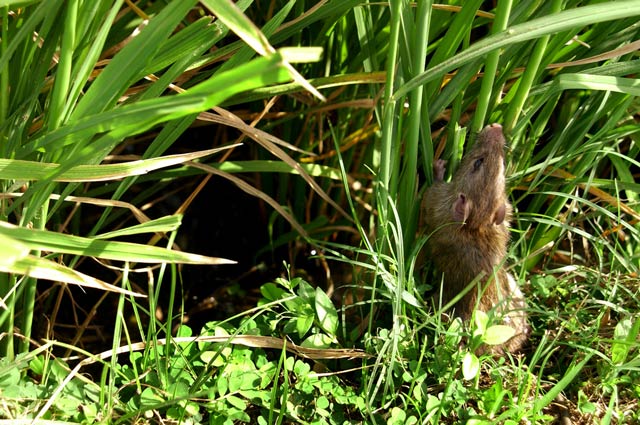Rat
Rattus argentiventer Robinson and Kloss, R. exulans Peale, R. rattus spp., R. tanezumi
What it does
Rice field rats cut or pull up transplanted plants. They also chop down the young seedlings. At booting stage, they feed on rice panicles. On the other hand, during ripening stage, they feed on developing rice grains.
Why and where it occurs
Rats are found in lowland irrigated rice crops. Both the wet and dry seasons are favorable for rat reproduction and crop damage. In rainfed rice crops rodents have their greatest impact in the wet season. The availability of food, water, and shelter are the factors, which provide optimum breeding conditions. The presence of grassy weeds also triggers their development.
Rice field rats feed at night with high activity at dusk and dawn. At daytime, they are found among vegetation, weeds, or maturing fields. During fallow period, they utilize major channels and village gardens as prime habitats. At tillering, 75% of time they are in burrows along the banks and after maximum tillering, 65% of time they are in rice paddies.
How to identify
Rat damage in the rice crop can be observed by the following symptoms:
- missing germinating seeds
- missing hills
- chopped young seedlings
- missing plants
- irregular cuttings of stem
- chewed developing buds or ripening grains
- tillers cut near base at 45° angle
- retillering of stems
- delayed grain maturity
- missing grains
- missing panicles
The feeding damage on the stem caused by the rice field rats may resemble insect damage although rat damage is usually distinguished by the clean cut at 45° of the tiller. The damage on the grains is similar to bird damage.
- Check muddy areas for runways, active burrows, and footprints of rice field rats. These are usually near the damage they have created.
- Check for presence of rice field rats: cut tillers and active holes on the bunds that surround the fields.
- When possible, catch rats to identify the species. Place traps along runways, or dug the rats from their burrows.
Why is it important
Rattus argentiventer is the major agricultural rodent pest across much of island and mainland Southeast Asia. Crop losses in rice-growing areas due to this species are typically in the order of 10−20%. Losses are generally higher in the second crop in areas with double cropping.
For fields positioned close to refuge habitats such as canals or extensive upland areas, chronic losses of 30−50% are reported. Very high chronic losses are also reported in areas where triple cropping is practiced and rat densities are especially high.
In Malaysia, this species has caused yield losses of 6−11%. In Indonesia, an estimated 17% of the total planted area is estimated to be damaged annually.
How to manage
The following are examples of effective community control:
- Flooding, digging, or fumigating rat burrows
- Scare rats out of areas with high vegetation cover or around villages (using netting, dogs, clubs, and others to catch rats)
- Use dogs to locate active rat burrows, then do Step 1
- Hunt rats at night using flashlights, clubs, bow and arrows, and netting
- Set local kill-traps along runways of rats
- Use registered rat poisons that are placed in covered bait stations (but not where children, pets, or livestock have easy access).
While field management includes:
- Keeping rice bunds (banks) in the crops less than 30 cm wide to prevent rats from burrowing.
- Keeping the edges of the field, the bunds, and surrounding areas clean and free of tall weeds and hiding areas for rats.
- Planting at the same time as your neighbors—within 2 weeks of each other.
- Strategizing the use of Trap Barrier System (TBS)—during the rice season with the most rodent damage.
- Keeping the area around fields, homes, and villages clean — no piles of wood or brush, no garbage heaps, no weedy areas.
- Keeping grain stores and surrounding area clean.
